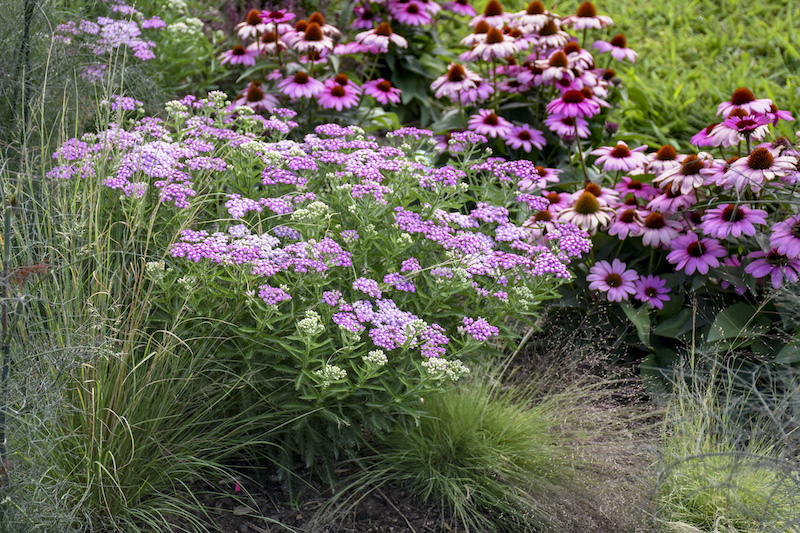Yarrow is a native plant that thrives in drier soil and can withstand drought and heat when well established in the garden. The root system is shallow and fibrous and spreads out in search of water and nutrients. With proper watering, the root system can be trained to go deeper in the soil where more moisture can be found in between supplemental waterings.

How To Tell If Yarrow Needs Watering
Yarrow gives very obvious signs when it needs to be watered. The lower leaves will begin to turn brown and droop. As the plant dries out more, the newest growth will turn yellow and also droop. Flower buds will fail to open and the stems will eventually dry up. When the flowers begin to die, it may be too late to water Yarrow. On the other hand, overwatering is very easy with Yarrow if it is planted in a garden near plants that require far more moisture. Overwatering symptoms are generally the same as underwatering: leaves will yellow and begin to die back.
How Often to Water Yarrow
Newly planted Yarrow needs at least one inch of water per week. Ideally this is spread out over 2-3 sessions. Longer, less frequent waterings will encourage deeper root growth and make for a plant that withstands drought better than a plant with shallow roots.
Once Yarrow is established the watering can be cut back to once a week or even longer. If you live in a climate that gets rain in the summer, supplemental watering may not be needed. Mulching the soil with arborist chips, finely shredded leaves or bark, or organic compost will help to make the soil much more moisture retentive over time. The mulch also helps to cool the soil which results in less moisture loss as well.
Watering Yarrow that is pot grown is a very different situation. Pots naturally dry out faster than garden soil and need to have daily monitoring for water needs. The type of pot material also makes a big difference to how often Yarrow will need watering. Terra cotta pots breathe very well, but also dry out the fastest of all the pots. Plastic and composite resin pots hold moisture much longer in the summer time and in the winter. Yarrow growing in pots should be let to dry out in between waterings so the top 1-2 inches of soil feel dry to the touch.
Watering with a drip irrigation system or soaker hose is the best way to water Yarrow in the garden. Drip lines or soaker hoses target water to the root zone of the plant unlike overhead sprinklers that lose much of the water that they put out to evaporation or off-target spraying. Many plants, like Yarrow, do not like to have wet leaves and benefit greatly from the drip lines and soaker hoses.
Best Time To Water
Watering for just about any plant is better if done early in the day while the soil may still be damp from dew. This ensures that the supplemental water will soak deep in the soil. Also, any foliage that gets wet from the watering has time to dry off during the day. Wet foliage on some plants leads to fungal and mildew disease. Keeping the leaves of susceptible plants dry is the best way to keep a plant healthy.
Winter watering is not often needed. Yarrow goes dormant in winter, even in the warmer hardiness zones. Too much water during the cold winter months will cause root rot and kill the plant.

How To Water Yarrow
Step 1 - Check the soil to see if it is damp under the surface. Sandy soils dry out the fastest, while soils with high clay content will retain moisture far longer and at lower levels.
Step 2 - Water with drip irrigation or soaker hoses at a rate that the soil can absorb.
Step 3 - Water until at least 5-6 inches of soil is wet under the surface.
Step 4 - Hand watering with a can or spray head should be done until there is a small amount of standing water on the surface of the soil.
Step 5 - Let the water soak in fully and then add more water to make sure that the lower levels of the soil are sufficiently wet.
Step 6 - Let Yarrow plants dry out a bit in between waterings.
Yarrow Watering Tips
- Yarrow is a native plant that prefers drier soil and is drought tolerant
- Overwatering and underwatering symptoms often are the same
- Fewer, longer watering session force the plant roots to grow deeper in the soil
- Good watering from the time of planting will help Yarrow establish well
 |
Author Robbin Small - Published 7-7-2022 |
